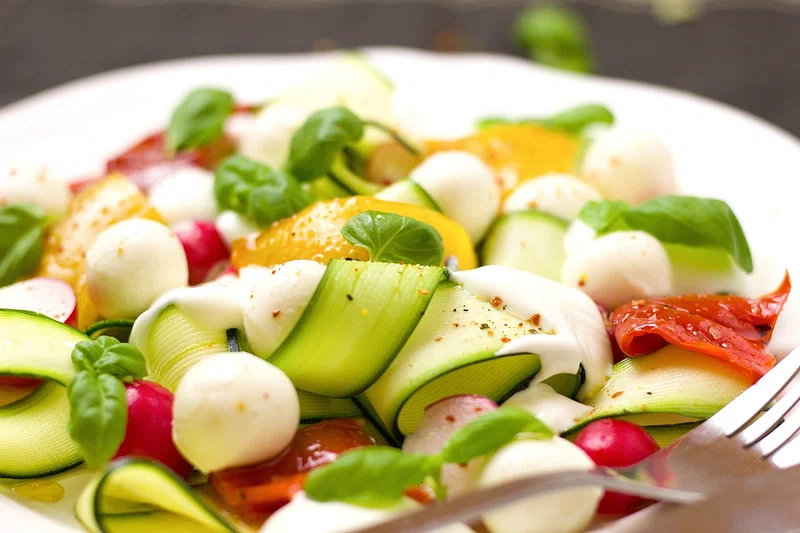How to Make a Delicious Salad with a Perfect Homemade Dressing
Salads are more than just a bowl of leafy greens; they are a versatile and nutritious meal that can be customized to fit any taste. But what takes a salad from good to great is a well-balanced dressing. In this blog, we’ll walk you through a simple yet delicious salad recipe and teach you how to make a flavorful dressing from scratch.
Why Make Your Own Salad Dressing?
Store-bought dressings are convenient, but they often contain preservatives, excess sugar, and unhealthy fats. Making your own salad dressing at home is easy, allows you to control the ingredients, and can elevate the flavors of your salad. Plus, it’s fresher and healthier!
Fresh Garden Salad with a Tangy Vinaigrette Dressing
Ingredients
For the salad:
- 4 cups of mixed greens (spinach, arugula, romaine, or any leafy greens of your choice)
- 1 cup of cherry tomatoes, halved
- 1 cucumber, sliced
- 1 small red onion, thinly sliced
- 1 avocado, diced
- 1/4 cup of roasted sunflower seeds (for crunch)
- 1/4 cup of feta cheese (optional)
- 1/2 cup of shredded carrots

For the vinaigrette dressing:
- 1/4 cup of extra virgin olive oil
- 2 tablespoons of apple cider vinegar (or balsamic vinegar)
- 1 teaspoon of Dijon mustard
- 1 clove of garlic, minced
- 1 tablespoon of honey (or maple syrup for a vegan option)
- Salt and pepper to taste
Step-by-Step Instructions
1. Prepare the Salad
Start by assembling the salad ingredients. Wash and dry your mixed greens thoroughly, as soggy leaves can make your salad less crisp. Place the greens in a large bowl.
Next, prepare the vegetables:

- Cherry tomatoes: Halve them for easy bites.
- Cucumber: Slice thinly for a refreshing crunch.
- Red onion: Thinly slice or dice, depending on how strong you like the flavor.
- Avocado: Dice it last to keep it fresh and avoid browning.
Add the shredded carrots, roasted sunflower seeds, and crumbled feta cheese to the bowl for additional flavor and texture.
2. Make the Vinaigrette Dressing
Homemade vinaigrette is simple and customizable. Follow these steps:
- In a small bowl or a mason jar, combine olive oil, vinegar, Dijon mustard, and minced garlic. These ingredients form the base of your vinaigrette.
- Add honey to balance the acidity from the vinegar and mustard. You can adjust the sweetness according to your preference. For a vegan option, you can substitute honey with maple syrup or agave syrup.
- Whisk the mixture well (or shake it in a jar) until the ingredients are emulsified, meaning they blend into a smooth, slightly thickened dressing.
- Season with salt and pepper to taste. You can also add herbs like oregano, thyme, or basil if you’d like to experiment with additional flavors.
Taste the dressing before serving. If it’s too tangy, add a little more olive oil; if it’s too bland, add more vinegar or mustard. The beauty of homemade dressing is that you can tweak it until it’s just right for you.
3. Toss the Salad with the Dressing
Drizzle the freshly made vinaigrette over the salad just before serving. Toss the salad gently using salad tongs or your hands, making sure all the ingredients are coated with the dressing.
4. Serve and Enjoy
Once everything is well-combined, serve the salad in individual bowls or as a large dish to share. This fresh garden salad pairs well with any meal or can be a light lunch on its own.

Additional Tips for Perfect Salad Dressings
- Balance the Flavors: A great salad dressing has a balance of acid, fat, and sweetness. Vinegar or citrus juice provides acidity, oil gives richness, and honey or syrup adds a touch of sweetness. Taste as you go and adjust as needed.
- Use Fresh Ingredients: Fresh garlic, herbs, and quality olive oil will enhance the flavor of your dressing. Avoid using pre-minced garlic as it can taste bitter over time.
- Emulsify: Whisking or shaking your dressing is key to emulsifying the oil and vinegar, ensuring they don’t separate quickly. Mustard helps with this process, but vigorous whisking will do the trick.
- Store in the Fridge: Homemade vinaigrettes can last up to a week in the fridge. Store them in a sealed container and shake well before using again. Some oils may solidify in the fridge, so just let it sit at room temperature for a few minutes before serving.
Variations on Salad Dressings
- Creamy Dressings: If you prefer creamy dressings, you can swap the vinaigrette with a creamy base like Greek yogurt, sour cream, or mayo. Add lemon juice for acidity and garlic for flavor.
- Citrus Dressing: For a light, summery twist, replace the vinegar with freshly squeezed lemon or lime juice. You can also add orange juice for extra sweetness.
- Herb Vinaigrette: Add fresh or dried herbs like thyme, oregano, or parsley for an earthy flavor. Basil and cilantro are also great additions for more vibrant, aromatic dressings.
Conclusion
Salads are versatile and delicious, but the secret to an unforgettable one lies in the dressing. Making your own salad dressing is a game-changer that brings fresh, natural ingredients into your meal, enhancing the flavors of the greens and veggies. The simple vinaigrette recipe we shared is a great starting point, but don’t hesitate to experiment with different herbs, citrus, or creamy bases to suit your preferences. Happy salad making!
Can I use any oil for a salad dressing?
How long does homemade salad dressing last?
What are the key ingredients for a basic salad dressing?
Fat: Most often extra virgin olive oil, but other oils like avocado or walnut oil work too.
Acid: Vinegars (apple cider, balsamic, red wine) or citrus juices (lemon, lime).
Emulsifier: Something to help the oil and acid mix, like Dijon mustard or honey.
You can also add salt, pepper, and herbs for seasoning.


